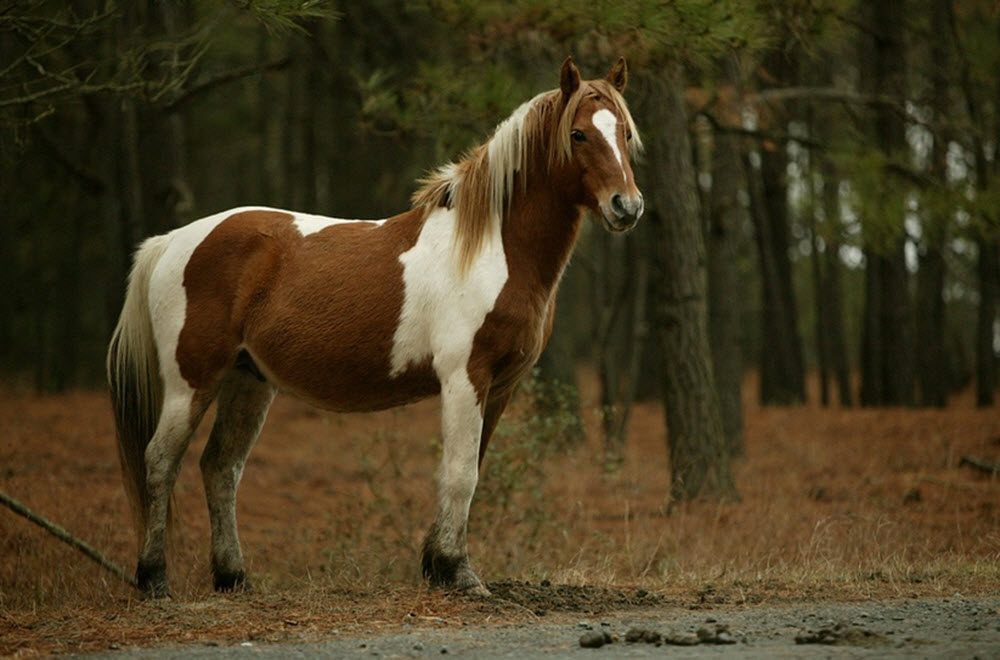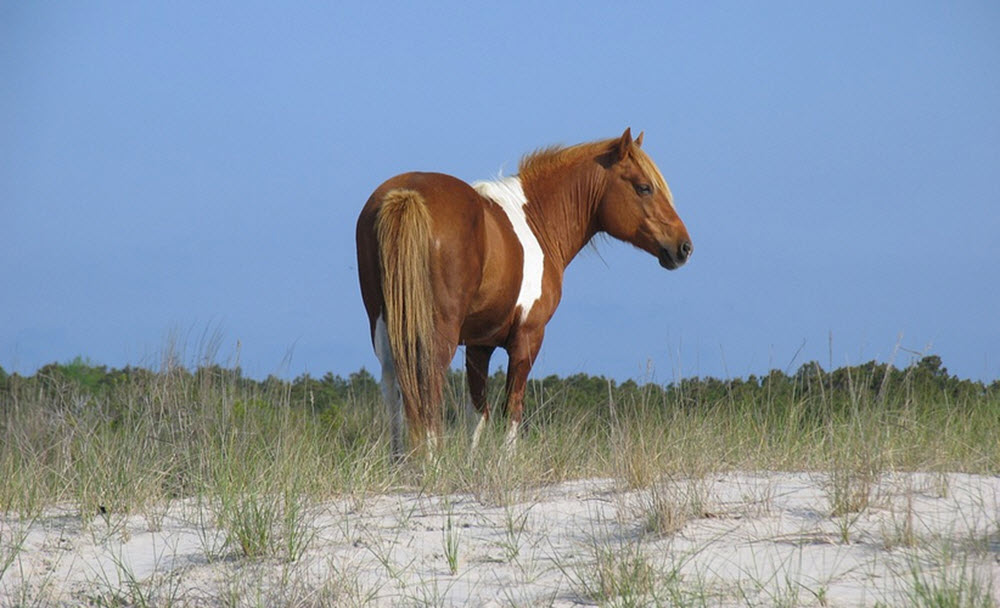On this page:
The Chincoteague pony, also known as the Assateague horse, is a breed of horse that developed in feral conditions on Assateague Island in the United States. This island – which is owned by the federal government – is divided between the states Virginia and Maryland, and a fence separates the two parts. Each side of the island have its own herd of Chincoteague ponies.

In the 20th century, quite a lot of horse (not pony) genetic material were introduced to the Chincoteague pony herd in an effort to make them higher, and they now display a lot of horse features. Despite this, they are still commonly referred to as ponies.
In addition to the ponies that still live on Chincoteague Island, there are roughly a thousand individuals living in other parts of the world, chiefly within the US and Canada.
Chincoteague ponies raised in non-feral conditions are generally described as intelligent, easy to train and willing to please. They are chiefly used for hunting, trail riding and driving. Chincoteague ponies tend to be of good health. They are easy keepers, as they hail from ponies adapted to survive on salt marsh plants and brush.
Management
Maryland
The Chincoteague ponies in the Maryland herd live within the Assateague Island National Seashore, a unit of the National Park Service system of the U.S. Department of the Interior. The National Park Service system largely treat the ponies as wild animals, although they are given contraceptives to prevent overpopulation. In official texts, the Maryland herd is commonly referred to as Assateague horses.
Virginia
The Chincoteague Volunteer Fire Company owns the ponies that live on the Virginia side of Assateague Island. These ponies live within the Chincoteague National Wildlife Refuge, a wildlife preserve operated by the U.S. Fish & Wildlife Service.
These ponies are inspected by veterinarians twice a year.
Once a year, an auction is held were it is possible to purchase larger foals. Some of them are purchased by buyers who removed them from the island, while others are purchased as an act of charity – the buyer donates the money to the fire department but allows the pony to go back and live with its herd.
Associations
- The National Chincoteague Pony Association was founded in 1985. It maintains a breed registry and studbook that register all eligible ponies, including those that come from private breeders.
- The Chincoteague Pony Association was founded in 1994, and only horses purchased from the annual auction can be registered with this organization.
Many ponies are registered with both associations.
Characteristics
Height
Chincoteague ponies average around 13.2 hands in their feral state.
Individuals that do not live out in the wild tend to grow a bit taller, up to 14.2 hands or even more.
Weight
They general weigh around 850 lbs.
Color
All solid colors are found in the breed, and pinto patterns are also present. Interestingly, individuals that display pinto patterns tend to fetch a higher price at the annual auction.

Body
In general, the Chincoteague pony has a straight or slightly concave face, with a bread forehead. The throatlatch and neck are refined.
The shoulders are well angled.
The chest is broad and the ribs are well sprung.
The back is short and the loins broad.
The croup is rounded.
The tail is thick and low-set.
Most individuals have straight legs. The legs are sound and sturdy, with dense bone.
History of the Chincoteague ponies
We don’t know exactly when the ancestors of the Chincoteague ponies came to the island, but colonists present on the island in the mid-to-late 1600s does not mentioned any feral horses being there.
What we do know is that in the 1600s, livestock on the mainland were subject to taxes and fencing laws, but these laws did not apply to the island. Therefore, mainland farmers had a strong incentive to bring their own cattle, sheep, horses, etc to the island.
In the early 1900s, a contemporary source described the ponies as “very diminutive, but many of them are of perfect symmetry and extraordinary powers of action and endurance.”
As late as the 1920s, the ponies were still not managed by any authority, and the uncontrolled inbreeding led to issues with malformations in some individuals, such as misshapen legs and narrow chests. At the same time, natural selection culled individuals with serious issues, and the herd consisted chiefly of very hardy and adaptable ponies. Quite a few of them were very small, less than 12 hands, probably as a result of the limited and poor-quality food available to them.
New blood
In the 20th century, genetic material from Welsh and Shetland ponies were introduced to boost the quality and genetic diversity of the herd.
Also, horses (not ponies) with pinto coloring were added, and the result of this is still clearly visible today, with the Chincoteague herd exhibiting more horse-like features than before. The pinto coloring has proved very popular among buyers at the annual auction.
In 1939, the Bureau of Land Management brought 20 of their mustangs to the island.
Also in the 20th century, some Arabian blood was added to the herd with the aim of adding height to the breed. One Arabian stallion was released with the herd, but died fairly soon in the harsh conditions. Another Arabian stallion was allowed to mate with Chincoteague mares that had been removed from the island, and once the mares were in foal, they were sent back to their herd again.
Legends
There are many legends about the origin of the Chincoteague ponies an how they ended up on the island.
One of them claims that the ponies are the descendants of Spanish horses that swam to the island from one or more ships, heading for Peru, that were shipwrecked off the Virginia coast in the 1500s. Two sunken Spanish galleons resting off the Virginia coast have been pointed out as a possible basis for this legend. .
According to another legend, pirates left horses on this island.
